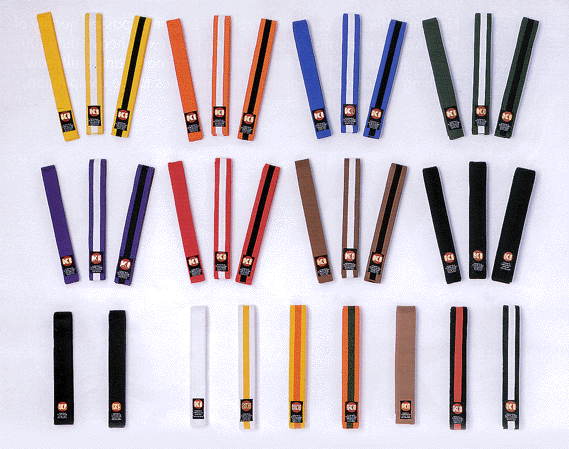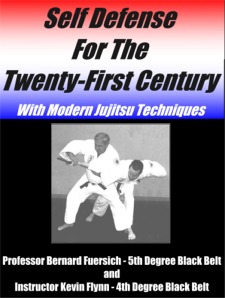|

One would think that the tying of the Obi (belt)
would be a simple matter and quite standard. In fact it's anything but
simple or standard. It would seem that there are 10 or so different
philosophies regarding how to tie ones belt. So what's a student to do?
When in doubt, tie your belt the way your instructor ties his belt.
Too Simple of an answer? Perhaps...
Having said that, there are a few customs are are
generally followed...
-
Any stripes on the belt should fall onto the
right side of the person when wearing the belt.
-
If one has writing on their belt only on one
side, the writing should fall onto the right side of the person when
wearing the belt.
-
If one has stripes on one side and writing on
both sides, then the stripes on the belt should fall onto the right
side of the person when wearing the belt.
-
And never, ever wash your belt.
Some Judo federations do have a rule for tournaments
regarding the tying of a belt.
Article #3 of the IJF regulations state: "A strong
belt, 4 to 5cm wide, whose color corresponds to the grade, shall be worn
over the jacket going twice around it at the waist, and tied with a
square knot with the first loops inside the knot, tight enough to
prevent the jacket from being too loose and long enough to leave 20 to
30 cm protruding from each side of the knot when tied".
Some schools even tie symbolism to the tying of
the knot....
Start with the center of the belt on your center
(navel) and wrap each side around your body (symbolizing the man and
earth). Then bring the right side over left and bring it upward around
all parts of the belt (symbolizing right conquers wrong). Then bring the
left side over right and feed it through the hole made (symbolizing that
if not careful, wrong can conquer right). So right conquers wrong but
wrong can conquer what's right if not careful.....
As for colors of the belt, again there are as many
varieties as there are schools.
White, Yellow,
Orange,
Green,
Blue,
Purple,
Brown
and Black
are some of the more popular colors.
Beyond Black there are Red and White belts (stripped
horizontally and vertically depending on rank) and solid Red belts.
But there are of course some general observations
that can be made.
-
Students start out as a beginner (white belt). In
old days, there were only two colors, white and black. The
"historical reference" is that a student would start with a white
belt and as he (or she) progressed, the belt would become dirty and
darker. Eventually the belt would be replaced with a black belt.
Now it is important to note that this sits more in legend then in
fact as belt color rankings did not even take hold until Kano crated
Judo.
-
Many schools also provide stripes on belt to
further differentiate ranks.
-
Most schools use belt rank to differentiate the
levels of students and will teach different techniques based upon
this ranking system.
-
As the student progresses, their belt changes
colors (usually from light colors to darker colors).
Dying of the belt
Another reason for progressing from light to darker
colors is based in the koru (old school) tradition of dying a belt. When
a student promoted to a new color belt, they did not receive a new belt,
but rather would soak their belt in fabric dye to change the color. This
was a practical solution in Japan after World War II when Japan was poor
and rebuilding. It is easier to dye a belt from lighter shades to darker
ones.
Philosophy of the circle
A student starts as a white belt and progresses
towards black belt. Once a student gets their black belt, it immediately
starts to fade and after a while, the inside white of the belt begins to
show more and more. This reminds the black belt that indeed they are
still a beginner, always needing to learn.
"The goal of white belts is to have a
black belt.... The goal of black belts is to again have a white belt..."
|
Final Thoughts on
Belt Color and Rank.
Some modern day schools
(often referred to as McDojo's) use belt colors as a revenue
generating form. Quick promotions and rank advancements (for a
fee) help to hold students and increase revenue through
promotional fees. I have seen some schools who promote so often
that the belt removed from the student is still stiff. Other
schools never, ever fail a student testing for advancement for
fearing of loosing that student. A good rule of thumb when
investigating a school is to ask the students how many tests
they have not passed. If no students have failed a promotional
test, then perhaps you should look for another school.
In my opinion, if belt
colors are to be used, White, Yellow, Green, Brown and Black
should be the foundation. Often one will find a difference
between kids and adults within a school. An example of this
would be a brown belt under 16 years of age being considered the
same as a green belt above 16 years of age. This is an important
differentiation as younger students often lack the mental as
well as physical requirements of an adult.
While I am on this
tangent, a 8 year old black belt will not NOT
NOT NOT be able to
defeat an adult. I can respect the child for his dedication and
admire their skill in kata and form. Being a martial artist with
25 years experience, I understand the intrinsic difference
between a young child and adult black belt. Do not let your
child believe falsely that they are safe because they have a
black belt.
With the multitude of
schools out there today; there are varying degrees of skilled
martial artists out there. A black belt at one school my be only
a green belt at another school. This imbalance happens for a
number of reasons. And since there is little push for standardization
between schools, the tradition of isolationism of styles
still holds true. As a result, you should never judge a persons
skill by their belt color. That would be like judging a book by
its cover. A true skilled martial artist makes their presence
known in short time.
Also it is important to
note that not all high level martial artists have the physical
ability to compete at the level their belt represents. This can
happen due to injury or perhaps just to age. In this case, the
person who has rightfully earned their rank through hard work
and sweat, deserves the respect that comes with the rank. Time
may take away ones capabilities to perform a technique, but the
knowledge of how to do the technique remains, ready to be shared
with all willing to learn. |
Remember, without safety, there can be no
Jujitsu.
|


